Drawing Restraint, dragging ambergris
February 5, 2006

Occidental Guest (bride), production still from Matthew Barney’s Drawing Restraint 9, copyright Matthew Barney, used without permission
Filled with expectation unsuitable for the company of friends, clutching a fat wad of tickets between fingers reeking of quickly eaten, mediocre sushi, it is unwise to view the best film of the festival first. It just ruins everything, and this is exactly what happened to me on January 30th when, in the exquisite ‘old’ Luxor cinema in Rotterdam, I saw Drawing Restraint 9.

Shimenawa, production still from Matthew Barney’s Drawing Restraint 9, copyright Matthew Barney, used without permission
Drawing Restraint is artist Matthew Barney’s 2006 film entry in the International Film Festival Rotterdam and as well the Berlinale Film Festival, where he is a member of the jury. Avant-pop artist, composer and girlfriend Bj├Ârk composed the soundtrack. Their collaboration is astounding on all levels; the film will make you cry, it is that beautiful. Aside from being culiblog’s favourite at this year’s festival, the film is exemplary of food-related film in the culiblog sense of the word; food, food culture, food as culture and the culture that grows our food.
Matthew Barney is the Lance Armstrong of contemporary art. In my opinion, no chef can yet lay claim to this position. Drawing Restraint 9 is also the best food-related film ever made, a lavish display of sensuality and ritual.
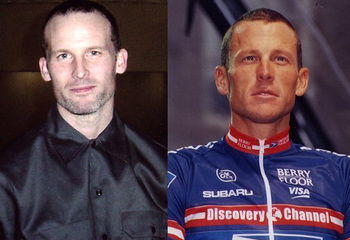
Barney on the left, Armstrong on the right
Drew Daniel of Matmos wrote this stellar description of Barney’s art practice on Bj├Ârk’s DR9 website:
Barney is a visual artist whose ambitious, rigorous multimedia work encodes esoteric meanings while providing lushly immediate aesthetic rewards. Best known for The Cremaster Cycle, the sprawling sequence of five films made over ten years which was the subject of a recent Guggenheim retrospective, Matthew Barney’s work is multimedia in execution but singularly focused in conception: tightly unified fusions of sculpture, performance, architecture, set design, music, computer generated effects and prosthetics, Barney’s films deploy the full range of cinematic resources in the service of a hermetic vision rich with densely layered networks of meaning drawn from mythology, history, sports, music, and biology.
This is a sexy way of saying that Barney’s work is based upon his own elaborate and logical cosmology. In Drawing Restraint he playfully turns materials, forms, geometries and processes (e.g. petroleum jelly, silicone, whale blubber, ambergris, other marine excretions and accretions), cultural-historical narratives and geographic trajectories (e.g. the architecture, interior and machinery of a whaling ship, the culture of whaling, the history of a specific ship) and the experience of time (e.g. pearl oyster divers holding their breath under water, the migration of whales, a Japanese tea ceremony), into a luscious weave of deeply connected meaning and narrative.
This is where chefs tend to slack off.
But this is Barney’s demarrage, an escape or breakaway that gives him an advantage over the rest of the ‘field’. Whereas it is common for a chef to create a ‘richly organized set of aesthetics’ (as Drew Daniel describes Barney’s approach to making art), I know of no example within the culture of contemporary haute cuisine in which a chef recontextualises elements on this level to form a total experience beyond the formal boundaries of restaurant culture. Perhaps I’m not going to the right sort of parties. I long for an haute cuisine that is less ‘applied’ and more autonomous.
The film has as its theme, the relationship between the self-imposed resistance and the transformative creativity inherent in the artistic process. I offer a simplified (flattened) overview of the narrative to suggest why this film is food-related, and a plea to the chefs of the world to step up their efforts and move towards creative autonomy.
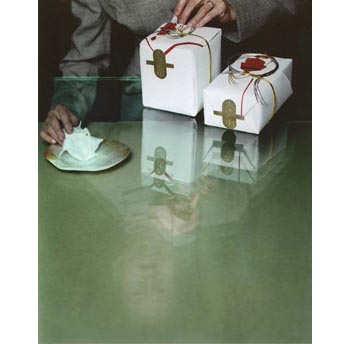
Dear General MacArthur, production still from Matthew Barney’s Drawing Restraint 9, copyright Matthew Barney, used without permission
The beginning sequence of the film is literally a gift. A moment for ritualised wrapping is accompanied by a most beautiful music track titled, ‘gratitude’, the text composed from a letter to General MacArthur by a Japanese citizen, thanking MacArthur for lifting the U.S. moratorium on whaling. This scene is an ode to plural sensilbities and cultures, a presentiment of the potential of blubber power vs. that of petrol power.
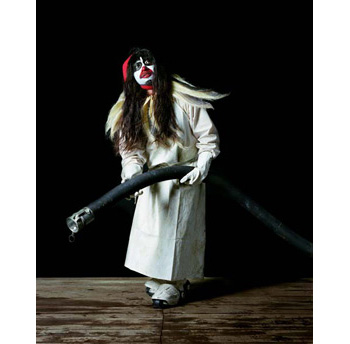
Petrolatum Spirit, production still from Matthew Barney’s Drawing Restraint 9, copyright Matthew Barney, used without permission
In the industrial harbour of Nagasaki Bay, a festively decorated lorry filled with liquid petroleum jelly is accompanied by a parade of merrymakers through a landscape of petroleum storage. Dockside, the whaling ship Nisshin Maru receives upon her decks Barney’s trademark sculptural form called ‘the Field’. During the course of the film the Field will be moulded, filled with molten vaseline, prodded with whaling implements, its contents rearranged violently and its surface will bear the signature of the voyage’s wave action. Eventually disembowelled and unmoulded, the Field will be allowed to disintegrate on the deck of the ship.
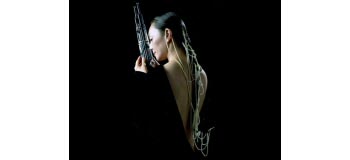
Sho player, production still from Matthew Barney’s Drawing Restraint 9, copyright Matthew Barney, used without permission
Women pearl oyster divers practice deep breathing techniques reminiscent of the sound of the sho before performing their dives. Floating in the waters, the women find a most massive log of ambergris, the size of a baby whale. Ambergris is resinous whale barf, caused by the irritating effects of ingested squid beaks and shrimp peel. Huge pools of cetacean vomit float upon the ocean’s surface, ocean-cured and kneaded by wave action. Ambergris is extremely valuable, used as a fixative in perfume making. Barney’s ‘ambergris log’ is taken on board the Nisshin Maru, as if it were a whale.
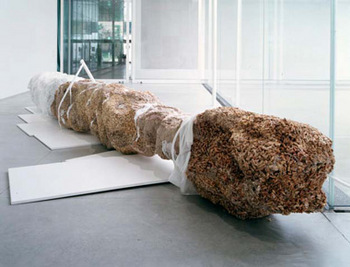
Ambergris, from Matthew Barney’s Drawing Restraint 9, copyright Matthew Barney, used without permission
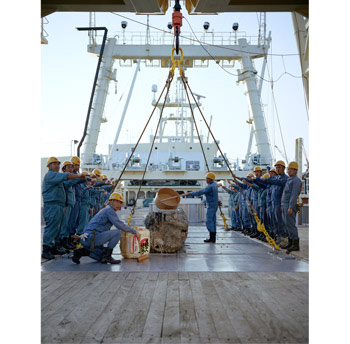
(Crew members pour sak├ę over the ambergris log.) Nisshin Maru (panel 4), production still from Matthew Barney’s Drawing Restraint 9, copyright Matthew Barney, used without permission
Metal barriers and rubber dams hold the slowly coagulating jelly in place as plate tectonic markings begin to appear on the Field’s surface. A parallel narrative begins when the ‘Occidental Guests’ played by Barney and Bj├Ârk, are taken on board, bathed and dressed in robes made from the skins of squid, marine and land mammals. Bj├Ârk´┐Żs teeth are blackened with (squid) ink and her hair adorned with magnificent porcupine-tined hair ornaments. The clothing, stunning in detail and brilliantly shot, is designed by Barney and is based upon traditional Shinto marriage costumes.
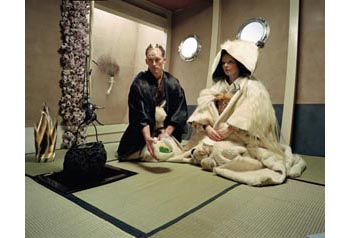
Occidental Guests, production still from Matthew Barney’s Drawing Restraint 9, copyright Matthew Barney, used without permission
Restraint becomes palpable as the couple participate in a tea ceremony hosted by the ship´┐Żs captain. In the only moment of spoken dialogue (albeit English, Japanese and Icelandic), the Captain recounts the history of the Nisshin Maru and jokes that the heady odour issuing from the log of ambergris is permeating every element of his ship. Back on deck, cranes lift the ambergris, positioning it within the centre of the Field, that it´┐Żs scent may further permeate the fatty substance.
In this hypnotic sequence, the Occidental Guests ritually sip thick, green tea from Barney-designed serviceware that would set Martin Kastner all a’drool. (Martin Kastner is the serviceware designer for Grant Achatz, chef of Alinea, just the sort of folk to whom I direct my plea for greater autonomy in the field of haute cuisine.) A lightening storm erupts, and the room in which the tea ceremony is being held begins to flood with liquid.
Knives out, the Occidental Guests initiate a transformation from land mammal to sea mammal by lovingly slicing off each other’s feet. In what can only be described as a climactic liebestod, the level of liquid in the tatami-matted chamber rises steadily as the Occidental Guests slice away at submerged blubber. Drawing blood in seminal stripes, they eventually reveal the results of their metamorphosis; phallic harbinger whale-tails. At the base of their necks, the Occidental Guests have developed vaginal breathing-spouts and can now survive under water.
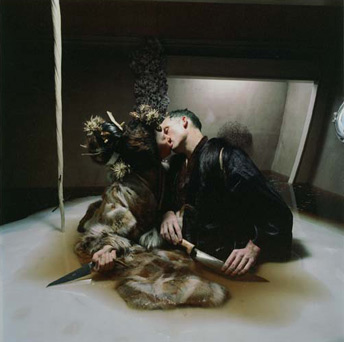
Shimenawa, production still from Matthew Barney’s Drawing Restraint 9, copyright Matthew Barney, used without permission
Paralleling the action below deck, the ship’s crew dismantles the Field’s metal barriers, cutting away the rubber dams that resemble a cetacean chin and the Nisshin Maru’s hull. Like a slaughtered whale, the Field surrenders its form, calving the icebergs that will appear in the next scene. Now it’s the industrial docks that are disintegrating. Pearls foam from the mouth of an oyster diver, like backwards bubbles falling to the ocean floor, the whaler Nisshin Maru follows its trajectory south towards Antarctica.
Chefs and designers, artists and gourmands, there is historical precedence for expanding and transforming our Field of Experience. Drawing Restraint is a finely tuned point of reference. Bon courage!
- Barbara Gladstone Gallery
- Bj´┐Żrk Drawing Restraint site with excellent ‘liner notes’ by Drew Daniel
- Interview with Matthew Barney by Hans Ulrich Obrist
- Excellent DR9 film review at Movie Martyr by Jeremy Heilman
- Matthew Barney fan site by conceptual bootleg artist, Eric Doeringer. Contains actual information.
- Matthew Barney’s Cremaster website
- An hilarious explanation of the Cremaster series, just for nerds.
- Drew Daniel c.s. (Matmos)
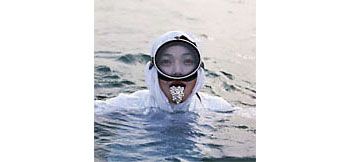
debra at 20:51 | | post to del.icio.us

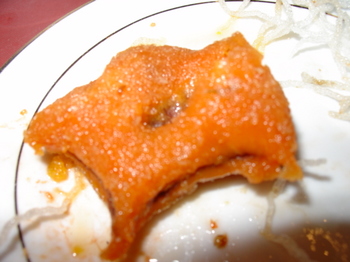
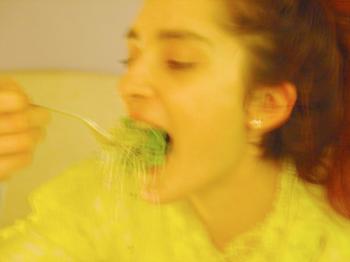
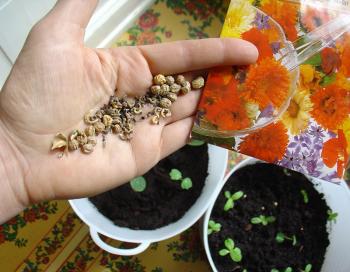
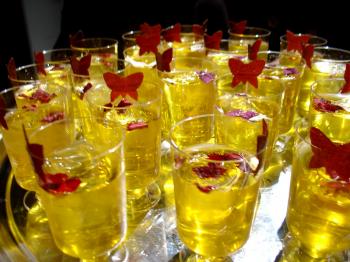
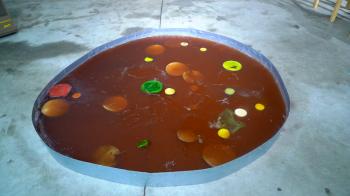
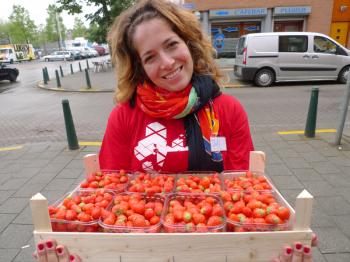











i can’t wait to see this movie. i have a vote for the lance armstrong/mathew barney chef: wylie dufresne. this chef is all about tranformative qualities—
Comment by b. — February 7, 2006 @ 0:40
From WD50, right? Hm. I have read his menus and found them to be exciting, not yet been to the resto, so I can’t judge. I am truly curious. Would you care to elabourate on the transformative quality of Wylie Dufresne’s work?
What I’m trying to say is that although there are a goodly amount of excellent chefs and culinary developments right now, the constraints put upon their creativity is still within the context of a commercially viable restaurant (experience). Don’t you find that a bit narrow? Can’t it be more than just a mind-blowing ‘dinner’? Where are the Gesamtkunstwerken in haute cuisine?
I mean, deconstruction occured in many other fields in the 1980’s. Haute cuisine’s molecular gastronomy still simply ends up on a plate (of sorts) on a very normal table, with very normal people eating it within the course of a relatively predictable 4-6 hour dining experience.
The producers of TVdinners and processed food have had a greater impact on the very nature of our eating and the context of our food (albeit NEGATIVE) than gastronomic ‘achievements’ of the past 30 years.
Time for my Sleepy Time tea, I think.
Comment by Debra — February 7, 2006 @ 2:23
You still have to watch a movie in a theatre and even then, it’s still just a movie.
Comment by ed — April 21, 2006 @ 0:33
Ya think? I felt transported completely.
Comment by debra — April 21, 2006 @ 6:58
Well, my esthete wannabees, this film is a big slice of crap, albeit big-dollar crap. We must all agree Barney is a genius at getting would-be art world players to pony up huge sums, I would guess at least twenty million US dollars, in order to be part of the big, deep show. However, the film is a tedious rehash of Barney obsessions (Vaseline, mainly) that might have come from a cursory reading of Krafft-Ebing — vis the amas and pearls scene. He is doing on the big screen what Hermann Nitsch did in performances and video, with borrowings from Damien Hirst and Gunther von Hagens, plus a big dose of Greenpeace PC. The Japanese setting makes it rather incomprehensible to Westerners, which makes it seem deep to art school undergraduates. I would guess this is the Yale art department’s imprint on a former football player and male model. And, Bjork is old enough now to be carrying a bit of junk in the trunk — unless that was her body double. Save your money for Hollywood trash — at least it has an actual plotline and fine bodies. And, keep learning how to draw…That’s still where real art starts.
Comment by Igor Georgievich Aleksandrov — July 22, 2006 @ 10:47
looks like theres a player hater amongst the commentators. I saw this when it came to the SF MOMA, and I have to say this was much more accessible and grounded than the cremaster series. I just bothers me to hear such trashy criticism, especially using the age old who-did-what first argument.
Comment by conor — November 17, 2006 @ 4:30
I loved it. I am a full time artist working in Scotland and found it inspiring. I think this film is also more accessible than the Cremaster series which I found hard, hard work. I think if Barney went one more 10% further with a thread of a plot, and the bravery to have an editor judiciously reel in a little flab, then he’d be up there with Lynch in the cinematic stakes. But lets be clear here, this is no rehash, the production value alone with the attention to detail and the incredible sondtrack all coalesce to a hell of a film!
Comment by Chris Dooks — October 27, 2009 @ 16:26